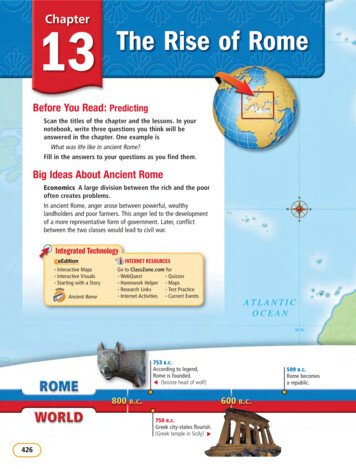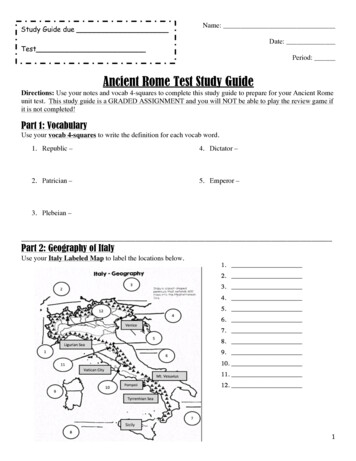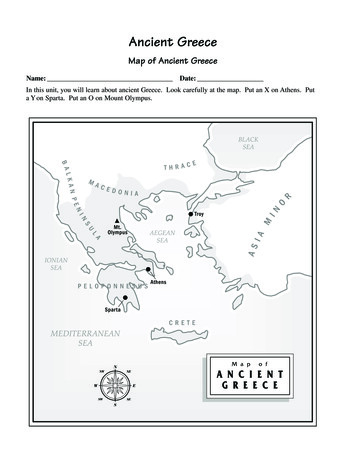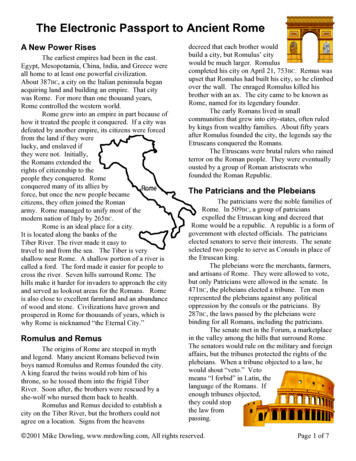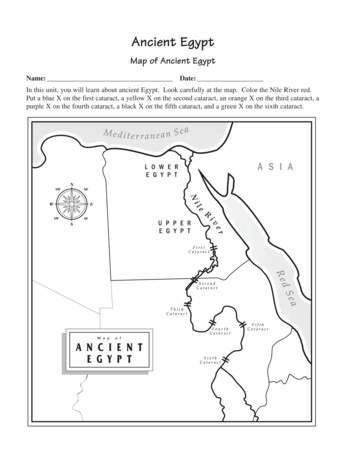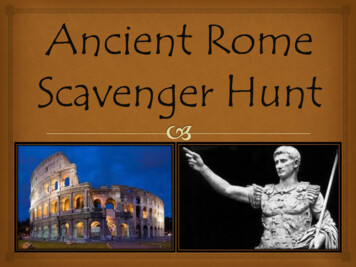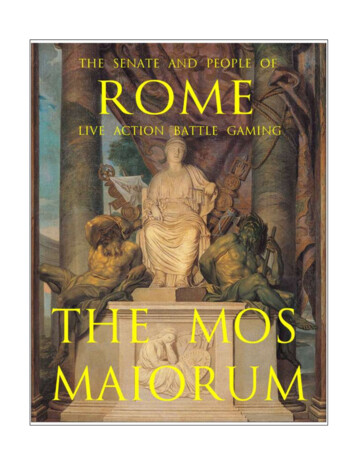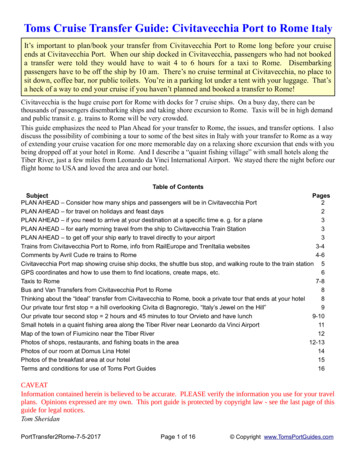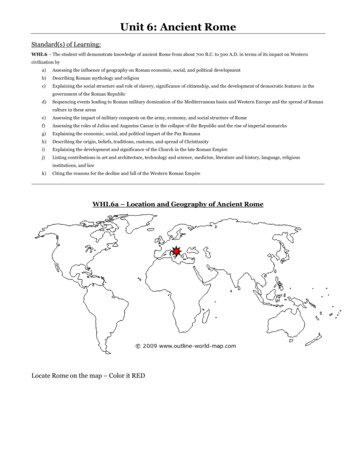
Transcription
Unit 6: Ancient RomeStandard(s) of Learning:WHI.6 – The student will demonstrate knowledge of ancient Rome from about 700 B.C. to 500 A.D. in terms of its impact on Westerncivilization bya)Assessing the influence of geography on Roman economic, social, and political developmentb)Describing Roman mythology and religionc)Explaining the social structure and role of slavery, significance of citizenship, and the development of democratic features in thegovernment of the Roman Republicd)Sequencing events leading to Roman military domination of the Mediterranean basin and Western Europe and the spread of Romanculture in these arease)Assessing the impact of military conquests on the army, economy, and social structure of Romef)Assessing the roles of Julius and Augustus Caesar in the collapse of the Republic and the rise of imperial monarchsg)Explaining the economic, social, and political impact of the Pax Romanah)Describing the origin, beliefs, traditions, customs, and spread of Christianityi)Explaining the development and significance of the Church in the late Roman Empirej)Listing contributions in art and architecture, technology and science, medicine, literature and history, language, religiousinstitutions, and lawk)Citing the reasons for the decline and fall of the Western Roman EmpireWHI.6a – Location and Geography of Ancient RomeLocate Rome on the map – Color it RED
The city of Rome, with its central location on the Italian peninsula, was able to extend itinfluence over the entire Mediterranean Basin.MountainsBodies of WaterCity of Rome Alps: located in the North and provided protection Apennines: run along the East coast of the Italian Peninsula Mediterranean and Adriatic Seas:oProvided protectionoSea-borne commerce (trade) Built on seven rolling hills on the Tiber River Located 15 miles inland – more easily defended Center of trade2
The Founding of RomeLatins Latium(700s B.C.)Etruscans Established a monarchy (rule by king) Took control of the monarchy and established a tyranny (rule by onepowerful ruler)(600s B.C.)Romans(500s B.C.)First settlers – formed villages along the Tiber River in an area called Transformed Rome into an urban center Developed a written language Skilled artists, metal workers, and architects Wealth Roman landowners overthrew the Etruscans and established aRepublic (elected representatives)3
WHI.6b – Roman Mythology & Religion Roman mythology, like Greek mythology, was based upon a polytheistic religion that was integralto culture, politics, and art.oBased on Greek polytheistic religionoExplained natural phenomena, human qualities, and life eventsRoman GodJupiterGreek NameZeusArea of ControlRuler of GodsGod of the SkyJunoHeraWife of JupiterGoddess of marriageDianaArtemisGoddess of earth, wildlife, huntersMinervaAthenaGoddess of wisdom and reasonVenusAphroditeGoddess of love and beauty Many of Western civilization’s symbols, metaphors, words, and idealized images come from ancientRoman mythology.oNames of Planets: Jupiter, Saturn, Mars, VenusoSymbols: Cupid (Valentine’s Day)4
WHI.6c – The Roman RepublicSenatus Populusque Romanus ("The Senate and the People of Rome")Although women, most aliens (non-Romans living in the Republic), and slaves were excluded from thegoverning process, the Roman Republic made major strides in the development of representativedemocracy, which became a foundation of modern democracy. Republic: form of government in which power rests with citizens who have the right to vote fortheir leadersSocial Structure in the Early Roman Republic Patricians: Power nobility (small portion of population)oInherited power and statusoMade laws for RomePlebeians: Majority of the populationoPlebeian men were allowed to vote, but were barred from holding most importantgovernment positions Slaves: Not based on raceThe Roman Republic Patrician and Plebeian men and selected foreigners Were required to pay taxes and serve in the militaryLegal Code Twelve Tables – written law codeExecutive Two Consuls, elected by the Assembly for one yearCitizenshipoActed as the chief executives of the government and commanderin-chief of the armyoHad the power to veto5
Censors: registered citizens according to their wealth and oversaw the moralconduct of all citizens LegislativeSenate – 300 members chosen from the wealthy who served for life – Mostpowerful group in the Republico Controlled foreign and financial policies and advised the consulsAssemblies: representative groups with one vote eachoVoted on laws and elected officialsoTribunes: special assemblies consisting of Plebeians who wereelected to protect the rights of the Plebeians from unfair acts ofPatrician officials – formed after the Conflict of Orders (Plebeianrebellion) JudicialRoman ArmyPraetors: 8 judges chosen for 1 year by the AssembliesoTwo judges oversaw the courtsoRemaining judges oversaw the provinces All citizens who owned land were required to serve in the army Soldiers were organized into large military units called legions (5,000infantry supported by cavalry) In times of crisis, the republic could appoint a dictator – a leader who had absolute power to makelaws and command the army.oPower lasted for only 6 monthsoChosen by consuls and elected by the Senate6
WHI.6d – The Punic Wars The Punic Wars were a series of conflicts between Rome and Carthage from 264-146 B.C. After the victory over Carthage in the Punic Wars, Rome was able, over the next 100 years, todominate the Mediterranean basin, leading to the diffusion of Roman culture1st Punic WarDates 264 BC – lasted 23 yearsCause(s) Rome feared Carthage would gain control of all of Sicily and cross the Straitof Messina into ItalyMajor EventsOutcome Rome came to the aid of the city of Messina when it rebelled against Carthage Rome builds a navy using captured Carthaginian ships as a model Used boarding bridges for hand to hand combat aboard enemy ships 241 BC – a peace agreement was signedoCarthage had to give up Sicily, Corsica, and SardiniaoCarthage had to pay money to Rome2nd Punic WarDates 218 BC – lasted 16 yearsCause(s) Carthage began to regroup and expand its empire in Spain Carthage attacks the city of Saguntum in Spain – an ally of Rome – and Romedeclares war on Carthage7
Major Events Hannibal, the great Carthaginian general, leads his army (includingelephants) through the Alps to invade Italy His plan against Rome was simple: early decisive victories and convinceRoman allies to side with Carthage Battle of CannaeoRomans adopted a delay approach to Hannibal. The plan was to waithim out until he was tired, supplies diminished, and not meet himhead on. Though effective this plan was not popular with the public orthe politicians.oThis policy would change for one battle, Cannae. New consuls wereelected with the promise of a decisive victory over Hannibal. They weregranted double their normal army to fight and decided to draw Hannibalout in the open. Rome out-numbered Hannibal 2-1.oHannibal soundly defeated the Roman army. About 10,000 of the70,000 Roman soldiers survived the fight. Hannibal’s tactics are stillstudied today as a maneuver to defeat a larger army on an open field.oAfter this battle Rome would go back to its delay policy and not openlyface Hannibal. While Hannibal was preoccupied, Rome sent a young general Scipio to SpainoConquered Spain and divided the area into two Roman provincesoScipio then crossed over to Africa and marched on CarthageoWith Hannibal in Italy, Carthage was somewhat defenseless againstScipio. They quickly called for peace and Hannibal was sent home,having won every major battle he had fought. Battle of ZamaoHannibal and Scipio face off on the battlefield near CarthageoScipio wins, delivering Hannibal’s first lost and complete defeat ofCarthageoThis battle ends the 2nd Punic War8
OutcomeCarthage was defeatedoLost territories in Spain and AfricaoLost most of its navyoForced to pay more money to Rome3rd Punic WarDates 149 BC – lasted 3 yearsCause(s) Hatred between Rome and Carthage Carthage tried to recover after the 2nd Punic War which upset Rome – Romedeclares war on CarthageMajor Events Rome attacks and burns the city of Carthage and sells the remaininginhabitants into slavery OutcomeRome dominated the Mediterranean basin which led to expanded trade,greater wealth, and the spread of the Roman cultureEffects of the Punic Wars Roman victory – lead to expanded trade and wealth for Rome Carthage is completely destroyed Roman culture spreads throughout the Mediterranean Basin (Africa, Asia, Europe, and EasternMediterranean) as well as Western Europe (Gaul, British Isles)Problems for Rome The Punic Wars also caused some problems for RomeoHigh unemployment and need for public welfareoSmall farmers lost their land – large portions of fields were destroyed during the warsoRome became dependent upon provinces for grain9
WHI.6e, f – The Decline of the Roman Republic The Roman Republic, in the face of changing social and economic conditions, succumbed to civilwar and was replaced by an imperial regime, the Roman Empire.Economic/Social Problems: Spread of slavery in the agricultural system – 1/3 of thepopulation were slaved Migration of small farmers into the cities and unemployment– ¼ of the populationMilitary Problems: Devaluation of the Roman currency due to inflation Period of civil war – conflict between groups within the samecountry Breakdown of the once loyal military – Generals began seizingpower and recruiting armies by promising land and payingsoldiers, which made the soldiers loyal to the Generals and notthe RepublicAttempts at ReformTiberius and Gaius Gracchus Tribunes who proposed reforms such as limiting the size ofestates and giving land to the poorLucius Cornelius Sulla Both were assassinated Ruled as dictator from 82 BC to 79 BC Tried to restore power to the Senate by enlarging it by 300members and giving it complete control over the government10
Julius CaesarThe First Triumvirate Means “Rule of Three” – a political alliance Consisted of: Julius Caesar (military leader), Gnaeus Pompey (popular general), LiciniusCrassus (wealthy Roman) Took power in 59 B.C. and ruled for 10 yearsJulius Caesar Takes Control Became a national hero after conquering Gual (France) Pompey worried about Caesar’s growing influence, so he had the Senate order Caesar to disbandhis army and return to Rome Caesar marched on Rome and defeated Pompey’s army – Senate named him dictator In 44 BC, he was named dictator for lifeRome Under Caesar Caesar ruled as an absolute ruler – end to democracy in Rome Granted Roman citizenship to many people in the provinces Expanded the Senate Created jobs through public building projects Started new colonies and raised pay for soldiersThe End of the Roman Republic Caesar made many enemies and in 44 BC he was assassinated by two Senators: Marcus Brutusand Gaius Cassius After his death, civil war broke out again and destroyed what was left of the Roman Republic11
Octavian (Augustus) CaesarThe Second Triumvirate Consisted of: Octavian Caesar (nephew of Caesar), Mark Antony (general), and Lepidus(powerful politician) Took power in 43 BC and ruled for 10 yearsOctavian Takes Control Octavian forces Lepidus to retire He then accuses Antony of treason – leads an army against him In 31 BC, Octavian assumed the name Augustus and became Rome’s 1st emperorWHI.6g – The Roman Empire & The Pax Romana The Pax Romana: 200 years of peace and prosperity under imperial rule Expansion and solidification of the Roman Empire, particularly in the Near East Augustus Caesar established the Roman Empire by instituting various reforms and policies thathelped to promote prosperity and stability12
Economic ImpactSocial ImpactPolitical Impact Expanded trade by:oEstablishing a uniform system of moneyoGuaranteeing safe travel and trade on Roman roads Returned stability to social classes Increased emphasis on the family Create a civil service – paid workers to manage the affairs ofgovernment Developed a uniform rule of lawThe Roman Empire After Augustus Augustus died in 14 AD There was no procedure for the peaceful succession of EmperorsJulio-Claudian Emperors Series of bad emperors all related to Caesar ruled for the next 54 years, including:CaligulaNeroDomitian Ruled 37-41 AD Mentally disturbed Ruled 54-68 AD Good administrator, but cruel Murdered many people and persecuted Christians Ruled 81-96 AD Paranoid dictator who executed many people13
Five Good Emperors Series of five emperors who ruled for about 100 years, including:NervaTrajanHadrianAntonius PiusMarcus Aurelias Ruled 96-98 AD Began the custom of adopting an heir Ruled 98-117 AD Empire reached its greatest extent Undertook vast building program Enlarged social welfare Ruled 117-138 AD Consolidated earlier conquests Reorganized the bureacracy Ruled 138-161 Reign largely a period of peace and prosperity Ruled 161-180 Brought empire to height of economic prosperity Defeated invaders Wrote philosophy14
WHI.6h, I – Christianity & The Roman Empire The followers of Jesus spread throughout the Roman Empire, bringing it into conflict with Romanpolytheism and eventually changing Western civilization.Jesus of Nazareth Around 63 BC, Romans had taken over Judea – the Jewish Kingdom At the age of 30, Jesus began his public ministry Jesus’ message appealed to many, especially the poor, and his popularity grew which concerned theRomans and Jewish leaders Many followers believed that Jesus was the promised Messiah (king) Jewish leaders accused him of blasphemy because they did not believe he was the Messiah Roman governor Pontius Pilate accused him of defying the authority of Rome Jesus was arrested and crucified (nailed to a large wooden cross to die) and his followers believehe ascended into heavenChristianity Spreads Christianity was spread by the apostles – especially Paul The Pax Romana made travel and the exchange of ideas easy which helped spread Christianity Common languages – Latin and Greek – allowed the message to be easily understood Christianity had wide spread appeal because: oEmbraced all people and gave hope to the powerlessoOffered a personal relationship with a loving GodoPromised eternal life after deathBy the late 3rd Century AD there were millions of Christians in the Roman EmpireThe Persecution of Christians Christians posed a threat to the Romans because they refused to worship Roman Gods, whichwas seen as opposition to Roman rule Used as scapegoats (groups/individuals that innocently bear the blame for others) for politicaland economic troubles As the Pax Romana ended, the persecution of Christians increased – Romans exiled, imprisoned,or executed Christians for practicing their beliefs15
Some were viewed as martyrs – people willing to sacrifice their lives for a belief or cause – whichinspired othersChristianity Becomes a World Religion In 313 AD Roman Emperor Constantine converts to Christianity and ends the persecution of theChristians In 325 AD church leaders wrote the Nicene Creed which outlined the basic beliefs of the church In 380 AD Emperor Theodosius makes Christianity the Empire’s official religionThe Church in the Late Roman Empire As the Roman Empire declined in the West, the Church of Rome grew in importance, followers, andinfluence The Church became a source of moral authority Loyalty to the Church became more important than loyalty to the Emperor The Church became the main unifying force of Western EuropeChurch Leaders Pope – head of the church Bishops – priests who supervised several local churches Priests – led small groups of Christians at the local level16
Christianity Jesus Has roots in JudaismWhere was the religion founded? IsraelIdentify the sacred writings and holy Bible – Old and New Testaments Christian doctrines established by early churchWho founded the religion?bookscouncilsMonotheistic or Polytheistic? MonotheisticMajor Beliefs, Customs, and Traditions Jesus as both Son and incarnation of God Life after death – Final judgment Personal relationship with God Ten Commandments Symbol: Cross Yes – follow the Ten Commandments and Jesus Popularity of the message Early martyrs inspired others Carried by the Apostles, including Paul,Based on this religion, is there a heavenand, if so, how do you get there?How and where did this religionspread?throughout the Roman Empire17
WHI.6j – Contributions of Ancient Rome Conquests and trade spread Roman cultural and technological achievements throughout the Empire Western civilization was influenced by the cultural achievements of RomeArt Sculptors created realistic portraits in stone Bas-relief: type of sculpture where images project from a flatbackground Mosaics: pictures or designs made from small pieces of stone, glass, ortiteArchitecture Frescoes: paintings in wet plaster Pantheon – Temple built to honor the gods Colosseum – amphitheater used for Gladiator fights and various otherpublic spectaclesTechnologyScience Forum – political and economic center of Rome Developed concrete which allowed them to build large structures Roads: built 60,000 miles of paved highways Aqueducts: bridge-like structures that carried water from the mountains Roman arches and domes Ptolemy: developed the Ptolemaic system – based on the belief that thesun, the planets, and the stars revolved around the Earth18
Medicine Emphasis on public health: public baths, public water systems,medical schoolsLanguage Latin: Language of the Roman EmpireoThe Roman (Latin) alphabet of 23 letters, plus J, Y, W, whichthe English added later is used todayoLatin continued to be spoken in most of Europe after the end ofthe Roman EmpireoAdopted by the Roman Catholic ChurchoMany scientific terms and English words have Latin origins Roman numerals Romance Languages: Latin is the parent language of Spanish, French,Italian, Portuguese, and RomanianLiterature Virgil’s Aeneid: epic of Aeneas (a Trojan Hero)Religion Roman mythology Adoption of Christianity as the imperial religion Twelve Tables – principle of “innocent until proven guilty” Belief that basic legal principles should apply to all peopleLaw19
WHI.6k – Decline and Fall of the Roman Empire Over a 300 year period, the western part of the Roman Empire steadily declined because of internaland external problems The Pax Romana ended with the reign in Marcus Aurelius in 180 AD – after him Rome had aseries of poor rulersCauses for the Decline of the Western Roman EmpireGeographic Size Difficulty of defense and administrationEconomy Trade was disrupted by invasions and pirate attacks Lack of expansion – lacked new sources of gold and silver – led to hightaxes Devaluation of Roman currency due to inflation – drastic drop in thevalue of money coupled with a rise in pricesMilitary Agricultural declined due to overworked soil and years of war Food shortages and disease spread leading to population decrease Independent general and armies posed a great threat to Rome Army membership started to include non-Romans, calledmercenaries (foreign soldiers who fought for money) resulting in adecline of disciplineMoral Decay People’s loss of faith in Rome and the family due to poor conditions in20
the EmpirePolitical Problems Civil conflict and weak administrationInvasion Attacks on bordersoGermanic tribes from the NorthoHuns (Mongol nomads from Asia) led by Attila the HunEmperors Attempt Reforms Despite its problems, Rome lasted for another 200 years In 284 AD, Diocletian – an absolute and harsh leader – became emperoroDoubled the size of the armyoTried to control inflation by setting fixed prices for goodsoTo make governing easier, he divided the empire into the Greek speaking East (Greece,Anatolia, Syria, and Egypt) and the Latin speaking West (Italy, Gaul, Britain, and Spain)oDiocletian took control of the East and appointed a co-ruler for the WestConstantine Rises to Power When Diocletian retired in 305 AD, civil war broke out In 311 AD, a young commander named Constantine takes control By 324 AD, Constantine reunited the Roman Empire In 330 AD, Constantine moved the capital from Rome to Byzantium (Turkey) and remained thecity ConstantinopleDivision of the Roman Empire Empire divides again after the death of Constantine The Western Roman Empire collapsed in 476 AD when it ceased to have a Roman Emperor The Eastern Empire survives and becomes known as the Byzantine Empire, which continuesuntil 1453 when it is invaded by the Ottoman Turks21
Unit 6: Ancient Rome Standard(s) of Learning: WHI.6 - The student will demonstrate knowledge of ancient Rome from about 700 B.C. to 500 A.D. in terms of its impact on Western civilization by a) Assessing the influence of geography on Roman economic, social, and political development b) Describing Roman mythology and religion
